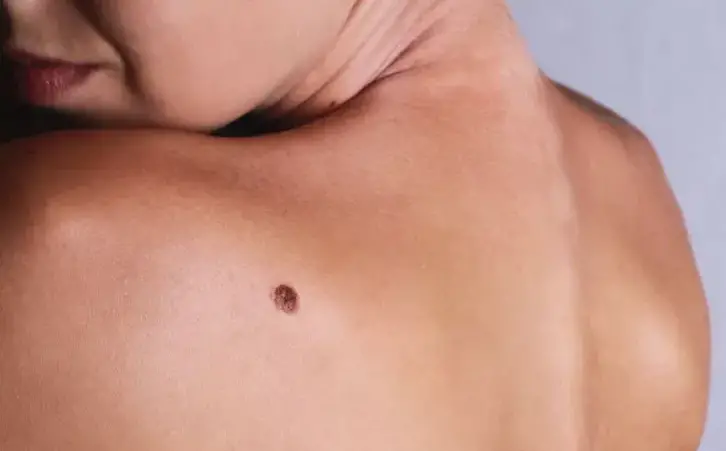Melanocytes are cells in the human skin that are certain to produce melanin, which is pigment that gives the color to the skin. The disease melanoma is developing in this cells, and is the most dangerous skin cancer. She is dangerous and can be more serious, then the other forms of skin cancer because is spread to other parts of body and cause death.
In the riskiest group that can be affected of this illness are especially women, the people under 40 years, and the people which are exposed on ultraviolet radiation.
Often melanomas can develop in areas of body that have exposure to the sun. But sometimes can be develop in other domains of the body like between toes, under a nail, in the mouth, digestive tract, vagina, urinary tract, in the eye. So she can be seen in the place which don’t have sun exposure and these type of melanoma is called hidden melanoma.
It’s good to be familiar with the severity of this disease, her symptoms, risks because if you treat her on time she can be remediable successfully. Melanoma can spread quickly to many parts of the body that can be deadly.
Symptoms
Usually sores, blemishes, moles, markings can be sign of melanoma. The symptoms of disease are:
- The development of a new pigmented or unusual-looking growth on your skin
- Change in an existing mole.
The most important signs of melanoma is the new spot on your skin, the spot that is changing her form and size, the spot that is looking different from other spots on your body.
The normal moles have tan, brown or black color, with the border that separate the mole from skin. The normal moles are smaller than ¼ inch in diameter and they are oval or round.
It’s important to know the rule of ABCDE to. With this you can indicate the melanomas:
A is for asymmetrical shape – look for moles with irregular shape;
B is for irregular border – notched or scalloped borders.
C is changes in color – different and many colors.
D is for different or irregular diameter.
E is for evolving in different color or shape
It’s good to make appointment with doctor if you detect skin changes that are unusual. Before appointment you must prepare and write down question to ask. Some of the basic questions are: ‘’Do I have melanoma? How large is? Has my melanoma spread? Can any treatment? What additional test do I need? Should I see specialist? What it will cost?’’
Risk factors
The factors that can increase risk of disease with melanoma can be:
- Sunburn – one or more blistering sunburns.
- Ultraviolet light exposure
- Fair skin – having less melanin in your skin.
- Unusual moles or many moles – if you have more than 50 moles on your body.
- Family history of melanoma
- Living closer to the equator
- Weakened immune system
- Previous skin cancer
- Age – above 50 years old.
Tests
When you do tests with your doctor is important during exams conducts a head-to-toe inspection of your skin. Also you can do skin exams and at home. You can watch closely look moles and other skin marks on your skin to notice changes. In front of full length mirror you should look in the hard to see places.
The only way to diagnose melanoma is biopsy. Biopsy is the simple taken from the body to examine it closely. They are three biopsy procedures that are used to diagnose melanoma:
- Punch biopsy: this type is with circular blade. The blade is pressed into skin around the mole and piece of skin is removed.
- Excisional biopsy – in this procedure the entire mole is removed.
- Incisional biopsy – only the irregular part of a mole is taken.
Melanoma stages
After you see your result, and it diagnosis melanoma, next is to determine stage of cancer.
Your doctor must first determine the thickness of melanoma under the microscope with micrometer. This need to help the doctor to make the treatment plan and estimate the serious the disease is.
Then your doctor must see if the melanoma has spread. If it’s spread the surgeon must recommend procedure which is known as sentinel node biopsy.
Treatments and drugs
The treatment of cancer depends of the stage, the size of melanoma. If the melanoma is thin she can be removed during the biopsy. After removing a thin melanoma no need other treatment.
If the melanoma is spread, she needs different options of treatment. First step is surgery to remove affected lymph nodes. Treatment or therapy before or after surgery also can be received. Also you can use chemotherapy to destroy cancer. Chemotherapy includes drugs to destroy cancer, and can be received in pills or intravenously or both.
Other type of therapy is radiation therapy which uses high – powered energy beams, such as X – rays. This therapy can also be recommended after surgery. Biological therapy help boosts your immune system to help fight with the cancer.
The most important thing is to know how to prevent melanoma. This can be achieved with wearing sunscreen year – round, avoid the sun in the middle of the day when it’s strongest, avoid tanning lamps and beads, wear protective clothes, Try to notice changes of your skin.

